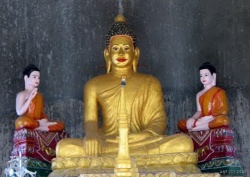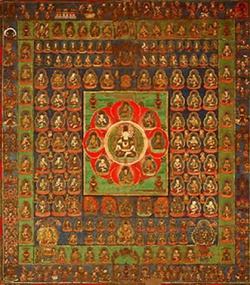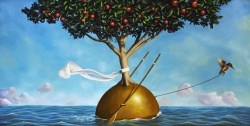Dípavamsa
Dípavamsa; The oldest extant Páli Chronicle of Ceylon. Like the Mahávamsa, it was based on the Atthakathá handed down in the Mahávihára of Ceylon. It gives the impression not of an evenly worked out whole, but rather of a stringing together of fragments, a composition of whole lines, sometimes whole stanzas, borrowed from the Atthakathá. It is generally agreed that the Dípavamsa assumed its present form about the fourth century A.C. It is stated (Cv.xxxviii.59) that Dhátusena made endowments for the regular recital of the Dípavamsa.
The Dipavamsa or Deepavamsa (i.e., "Chronicle of the Island"; in Pali: Dīpavaṃsa), is the oldest historical record of Sri Lanka. It means Chronicle of the Island. The chronicle is believe to be compiled from Atthakatha and other sources around the 3-4th century. Together with the Mahavamsa, it is the source of many accounts of ancient history of Sri Lanka and India. Its importance resides not only as a source of history and legend, but also as an important early work in Buddhist and Pali literature.
Contents
It is probably authored by several Buddhist monks of the Mahavihara tradition of Anuradhapura in the 3rd-4th century. The preamble begins with "Listen! I shall relate the chronicle of the Buddha's visits to the island, the arrival of the Tooth Relic and the Bodhi tree, the advent of the Buddha's doctrine, the rise of the teachers, the spread of Buddhism in the island and the coming of Vijaya the Chief of Men". King Dhatusena (4th century) had orderd that the Dipavamsa be recited at the Mahinda (son to Asoka) festival held annually in Anuradhapura.
The Dipavamsa refers to three visits to the Island by the Buddha, the places being: Kelaniya, Dighavapi, the place where the Bo-sapling was later planted within the Maha Mewna-uyana (Park) of Anuradhapura. It does not make any mention of the Buddha visiting the Samanalakanda (Adam's Peak).
Depiction of Buddhist sects
The Dipavamsa generally portrays the other early Buddhist schools in a negative way, and in one instance compares them to thorns on a banyan tree.
These 17 sects are schismatic,
only one is non-schismatic.
With the non-schismatic sect,
there are eighteen in all.
Like a great banyan tree,
the Theravāda is supreme,
The Dispensation of the Conqueror,
complete, without lack or excess.
The other sects arose
like thorns on the tree.
— Dīpavaṃsa, 4.90–91
Relationship to the Mahavamsa
Regarding the Vijaya legend, Dipavamsa has tried to be less super-natural than the later work, Mahavamsa in referring to the husband of the Kalinga-Vanga princess, ancestor of Vijya, as a man named Sinha who was an outlaw that attacked caravans en route. In the meantime, Sinha-bahu and Sinhasivali, as king and queen of the kingdom of Lala (Lata), "gave birth to twin sons, sixteen times." The eldest was Vijaya and the second was Sumitta. As Vijaya was of cruel and unseemly conduct, the enraged people requested the king to kill his son. But the king caused him and his seven hundred followers to leave the kingdom, and they landed in Sri Lanka, at a place called Tamba-panni, on the exact day when the Buddha passed into Maha Parinibbana.
The Dipavamsa gives a fuller account of the arrival of Theri Sangamitta(daughter to Asoka), but the epic story of Dutugamunu is treated only briefly, in ten Pali stanzas, while the Mahavamsa devoted ten chapters to it.
The Dipavamsa is considered "source material" to the Mahavamsa, The latter is more coherently organized, and is probably the greatest religious and historical Epic work in the Pali language. The historiography (i.e., the chronology of kings, battles etc.) given in the Mahavamsa, and to that extent in the Dipavasma, are believed to be largely correct from about the time of the death of Asoka.
Translations
The Dipavamsa has been translated into English by B. C. Law.
The work was edited and published by Oldenberg in 1879. For details see Geiger: Dípavamsa and Mahávamsa.


